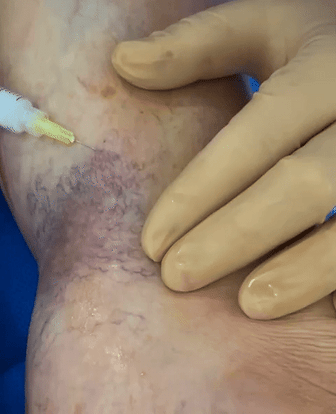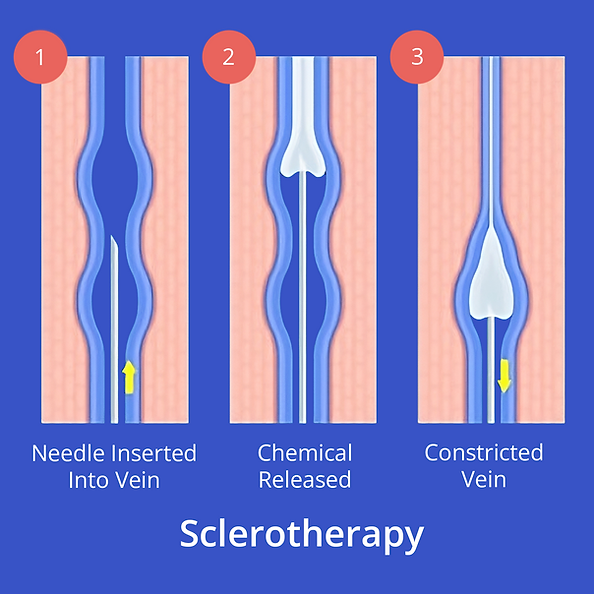Spider Veins
What are they?
Spider veins or thread veins, also known as telangiectasias, are small, twisted blood vessels that are visible near the surface of the skin. They typically appear red, blue, or purple and most often develop on the legs or face. They get their name from their resemblance to spiderwebs. Spider veins are usually harmless and don't cause any health problems. However, some people may find them unsightly and choose to have them treated for cosmetic reasons.

Treatment for Spider Veins
Sclerotherapy
Sclerotherapy is a medical procedure used to treat varicose veins and spider veins, which are dilated and visible veins often found on the legs. The procedure involves injecting a solution (sclerosant) directly into the affected veins, causing them to shrink, close off, and eventually be reabsorbed by the body. This helps improve blood circulation by redirecting blood flow to healthier veins.

How does it work?
The sclerosant solution inflames the lining of the vein, leading to the formation of scar tissue. This scar tissue eventually closes the vein, causing it to collapse and fade from view. Over time, the treated vein is absorbed by the body, and blood flow is rerouted to other healthier veins.
Sclerotherapy is a minimally invasive procedure and is often performed on an
outpatient basis. It is commonly used to alleviate the symptoms of varicose veins and spider veins, such as pain, discomfort, swelling, and cosmetic concerns. The procedure may require multiple sessions to achieve the desired results, depending on the extent of the vein problem.

Sclerotherapy works by causing controlled damage to the walls of the targeted varicose or spider veins and triggering a healing response that eventually closes off and eliminates the treated veins. (Sclerotheapy may be used in conjunction with Endovenous Laser Ablation (EVLA) to treat veins that are not suitable for laser).
Treatment Process
What are the steps involved?
1. Injection: During the procedure, the patient is usually lying down. A fine needle is inserted into the targeted vein, and a sclerosant solution is injected directly into the vein. The solution irritates the inner lining of the vein, causing it to swell and stick together.
2. Compression: After the treatment, the doctor may apply compression through a bandage or compression stocking to help keep the treated vein walls in contact. This pressure helps to promote the closure of the vein.
Healing Process
Over the next few weeks, the injected vein begins to undergo changes. The
irritation caused by the sclerosant solution leads to the formation of scar tissue along the vein's inner lining. This scar tissue gradually closes off the vein, causing it to collapse and become sealed shut.
As the vein closes, the body's natural processes work to break down and
absorb the sealed vein. Blood flow is redirected to healthier veins nearby.
Over time, the treated vein fades from view and is no longer visible on the surface of the skin. Any associated symptoms, such as pain, swelling, or discomfort, may also improve.
Follow-Up
Multiple sclerotherapy sessions may be necessary to achieve optimal results,
depending on the severity of the condition and the specific veins being treated. Follow-up appointments with the doctor will be scheduled to monitor progress and determine if additional treatments are needed.